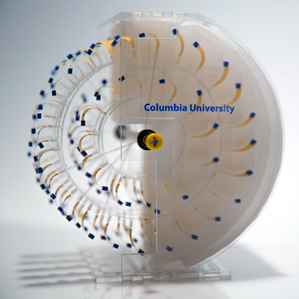Scientists Capture the Energy of Evaporation to Drive Tiny Engines
Harnessing the power from a fundamental process that’s happening constantly, all over the world, a team of scientists at Columbia University have devised tiny engines powered by evaporation. The devices generate electricity from the energy produced by bacterial spores known as Bacillus subtilis, which exhibit strong mechanical responses to changing relative humidity.

The spores expand when they absorb water and contract when they dry out. By controlling the moisture in the air, produced by evaporation, that the spores are exposed to, the devices grab the energy of these expansions and contractions to drive rotary or piston engines. The research was published on Tuesday in the journal Nature Communications.
The idea sprang from research into the mechanical properties of the subtilis spores, which can exist in a dormant state for hundreds of years. “It struck me as amazing how much mechanical energy they seem to have,” says Ozgur Sahin, an associate professor of biological sciences at the university. “They are so rigid that as the material’s shape changes it produces a lot of energy.”
Sahin glued the spores to a tape made of polyimide—a polymer used in fuel cells, computer displays, and various military applications—and surrounded them with a shutter mechanism that controls the passage of moisture. The shutter is essentially an oscillator, a mechanical switch like an electrical circuit, that opens and closes in response to the force produced by the spore changing shape. The opening and closing of the switch produces the regular pulsing of the swelling and shrinking spores. When the shutter is open, moisture escapes to the air and the spore dries out; when it closes, moisture fills the gap, the humidity increases, and the material expands.
An eight-centimeter by eight-centimeter water surface can produce about two microwatts of electricity (a microwatt is one-millionth of a watt), on average, and can burst up to 60 microwatts, says Sahin. That doesn’t sound like a lot of electricity; so far Sahin and his team have used the evaporation engines to power an LED and a miniature car that weighs a tenth of a kilogram.
“We made a lot of compromises in creating this version in hopes of creating a self-sufficient device,” he says. “We know actually that it can be made 100 times more powerful by solving a number of problems.”
Those solutions include adjusting the size of the moisture cavities and the mechanism of the shutters that control the flow of moisture. Sahin believes that arrays of the devices on the surface of lakes or other bodies of water could produce a scalable renewable energy technology, but that is likely years off, if it ever happens at all. One possible use could be to create battery-size “bricks” of spores than can be activated to produce electricity—just add water.
The tiny engines may have no practical applications in the near term, but they’re still a useful demonstration of the ubiquity of natural energy that can—at least in theory—be harnessed by relatively simple and cheap devices.
As Sahin says, unlike solar and wind power, “Evaporation is not intermittent.”
Keep Reading
Most Popular
Large language models can do jaw-dropping things. But nobody knows exactly why.
And that's a problem. Figuring it out is one of the biggest scientific puzzles of our time and a crucial step towards controlling more powerful future models.
The problem with plug-in hybrids? Their drivers.
Plug-in hybrids are often sold as a transition to EVs, but new data from Europe shows we’re still underestimating the emissions they produce.
Google DeepMind’s new generative model makes Super Mario–like games from scratch
Genie learns how to control games by watching hours and hours of video. It could help train next-gen robots too.
How scientists traced a mysterious covid case back to six toilets
When wastewater surveillance turns into a hunt for a single infected individual, the ethics get tricky.
Stay connected
Get the latest updates from
MIT Technology Review
Discover special offers, top stories, upcoming events, and more.